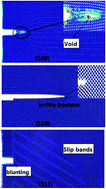Crystal orientation dependence of crack growth and stress evolution in single crystal nickel: a molecular dynamics simulation-based cohesive zone model
Abstract
The crack growth and stress evolution of single crystal nickel under three different crystal orientations (X[100], Y[010], Z[001]; X[110], Y[![[1 with combining macron]](https://www.rsc.org/images/entities/char_0031_0304.gif) 10], Z[001]; X[111], Y[
10], Z[001]; X[111], Y[![[1 with combining macron]](https://www.rsc.org/images/entities/char_0031_0304.gif) 10], Z [
10], Z [![[1 with combining macron]](https://www.rsc.org/images/entities/char_0031_0304.gif)
![[1 with combining macron]](https://www.rsc.org/images/entities/char_0031_0304.gif) 2]) were studied by introducing a cohesive zone model (CZM) based on molecular dynamics (MD) simulation. The results indicated that different crystal orientations have significant effect on the fracture mechanisms and stress distribution characteristics. Under the X[100], Y[010], Z[001] orientation, void nucleation and growth was observed during the crack propagation; under the X[110], Y[
2]) were studied by introducing a cohesive zone model (CZM) based on molecular dynamics (MD) simulation. The results indicated that different crystal orientations have significant effect on the fracture mechanisms and stress distribution characteristics. Under the X[100], Y[010], Z[001] orientation, void nucleation and growth was observed during the crack propagation; under the X[110], Y[![[1 with combining macron]](https://www.rsc.org/images/entities/char_0031_0304.gif) 10], Z[001] orientation, atomic configurations basically remained unchanged throughout the crack growth, which represented a brittle process; dissimilarly, blunting and slip bands occurred at the front of the crack tip for the X[111], Y[
10], Z[001] orientation, atomic configurations basically remained unchanged throughout the crack growth, which represented a brittle process; dissimilarly, blunting and slip bands occurred at the front of the crack tip for the X[111], Y[![[1 with combining macron]](https://www.rsc.org/images/entities/char_0031_0304.gif) 10], Z[
10], Z[![[1 with combining macron]](https://www.rsc.org/images/entities/char_0031_0304.gif)
![[1 with combining macron]](https://www.rsc.org/images/entities/char_0031_0304.gif) 2] orientation. These different mechanisms resulted in different stress distributions along the crack path and crack growth rates. Moreover, based on the calculation of the CZM, the relationship between stress and opening displacement was obtained, which provided useful information for understanding the crystal orientation dependent on the atomic-scale fracture mechanisms and associated mechanical properties.
2] orientation. These different mechanisms resulted in different stress distributions along the crack path and crack growth rates. Moreover, based on the calculation of the CZM, the relationship between stress and opening displacement was obtained, which provided useful information for understanding the crystal orientation dependent on the atomic-scale fracture mechanisms and associated mechanical properties.


 Please wait while we load your content...
Please wait while we load your content...